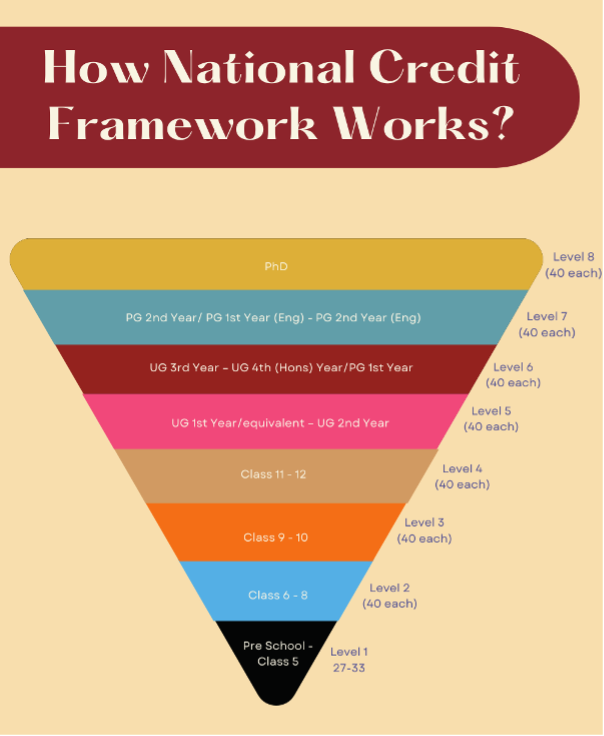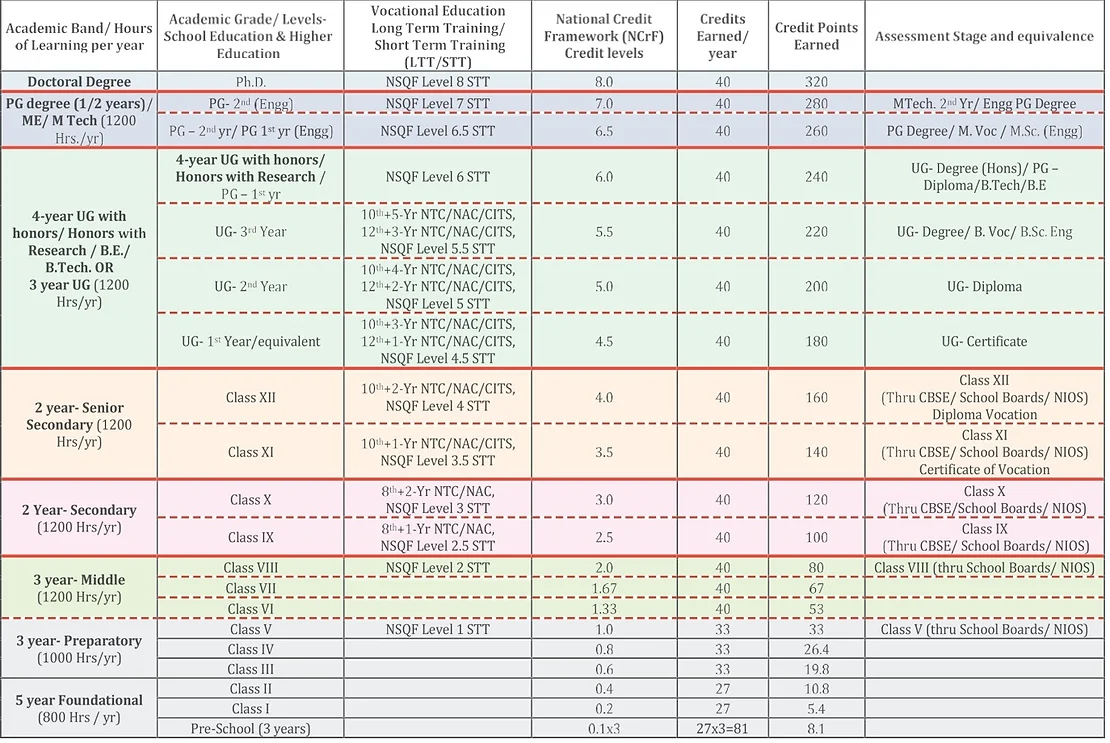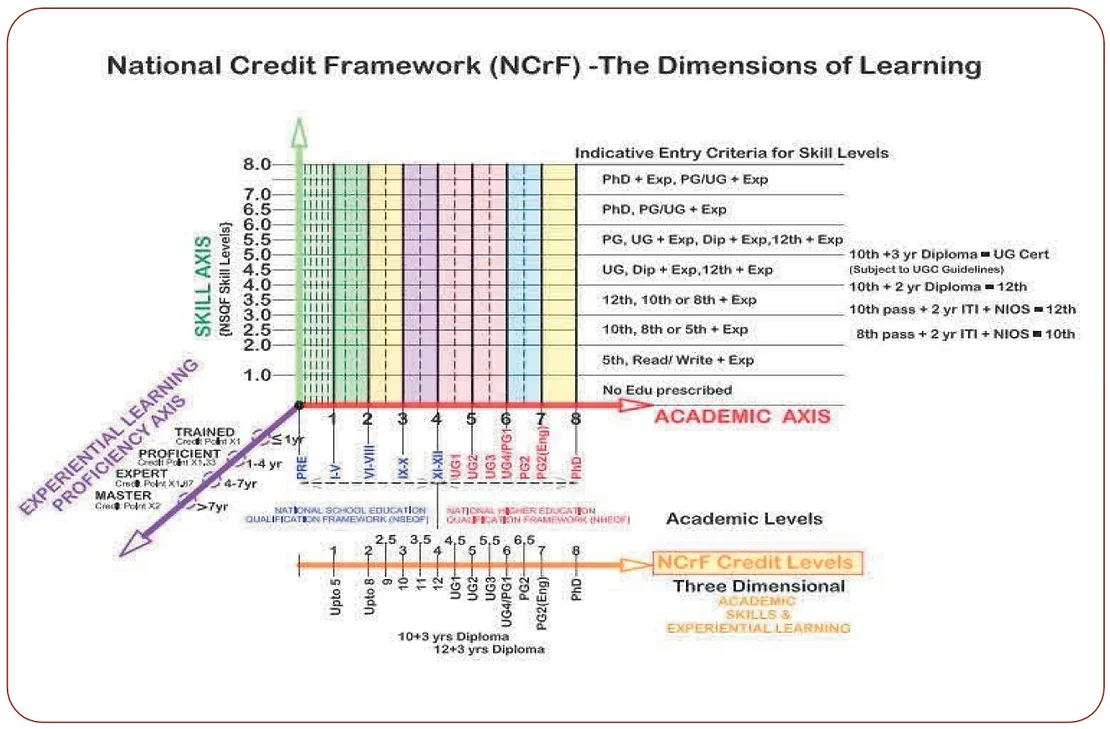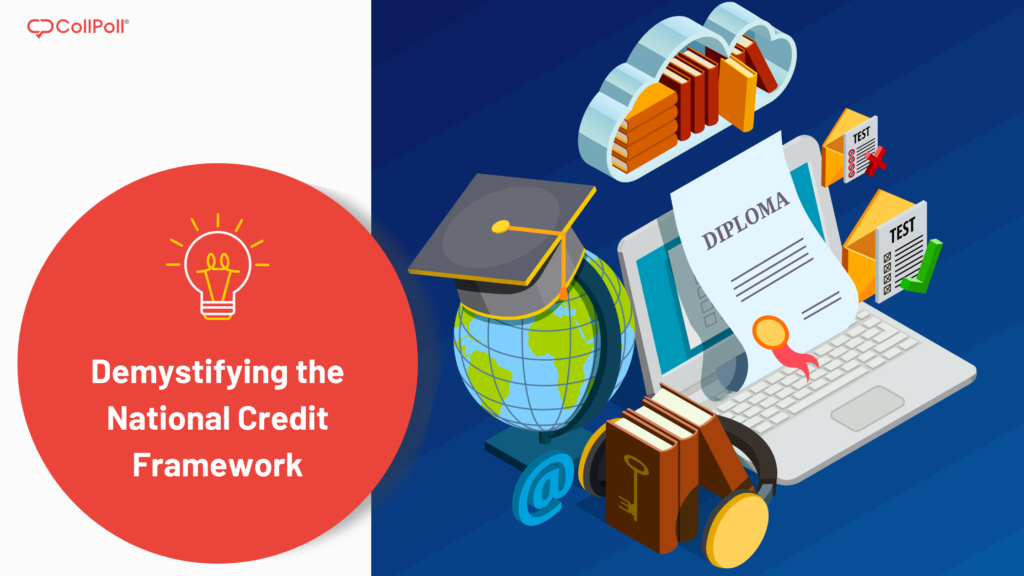The National Credit Framework (NCrF) is a comprehensive and flexible framework that provides a standardized and transparent system for measuring learning outcomes and awarding credits across all levels of education in India. The NCrF is aligned with existing qualification frameworks, including the National Higher Education Qualification Framework (NHEQF) and the National Skills Qualification Framework (NSQF). It aims to provide a seamless and integrated approach to education, where there is no rigid separation between academic, extracurricular, and vocational streams in schools. The framework also enables the recognition of prior learning (RPL) and the inter-transfer of students between different streams, subjects, curriculums, institutions, universities, boards, and education systems in India and abroad.
Genesis of the National Credit Framework
The genesis of the National Credit Framework (NCrF) can be traced back to the National Education Policy 2020, which emphasized the need for a flexible and multidisciplinary education system that would enable students to choose their own learning trajectories and programs. The policy aimed to promote vocational education and skilling, ensure the unity and integrity of all knowledge, and provide a seamless and integrated approach to education, where there is no rigid separation between academic, extracurricular, and vocational streams in schools.
To achieve these objectives, the policy proposed the development of a National Curriculum Framework (NCF) and a National Credit Framework (NCrF) that would enable the recognition of prior learning (RPL) and credit transferability across different levels of education. The NCrF was envisaged as a comprehensive and flexible system for measuring learning outcomes and awarding credits that would provide a standardized and transparent system for assessing and recognizing the achievements of students/learners.
The NCrF is aligned with existing qualification frameworks, including the National Higher Education Qualification Framework (NHEQF) and the National Skills Qualification Framework (NSQF), and is designed to provide a seamless and integrated approach to education. It enables a mix of arts, science, humanities, and life skills, including employability skills, etc., and encourages the entire education system to be creative and innovative because of the multidisciplinary approach to learning. The framework also gives due weightage to experiential learning, including relevant experience and proficiency/professional levels acquired, which is now included as a part of the overall learning hours.
Assignment of Credits
The National Credit Framework (NCrF) provides a standardized and transparent system for measuring learning outcomes and awarding credits across all levels of education in India. The credit assignment process in the framework is based on the achievement of specific learning outcomes, rather than just the number of hours spent in learning.
For academic and non-academic courses, the credit assignment is based on the level of learning achieved by the student. This learning can be acquired through classroom learning, self-study, project work, research work, or other forms of experiential learning. The NCrF enables the transfer of credits from one program or institution to another, allowing students to have flexibility in choosing their learning trajectories.
In addition, the NCrF recognizes the value of vocational education, training, and skilling and provides credit assignments for the same. The vocational education and skilling programs would also be available to students and learners enrolled with the National Institute of Open Schooling (NIOS), State Open Schools, adult literacy, and life-enrichment programs, including the availability of soft-skills and life skills such as communication, cooperation, teamwork, and resilience.

Figure 1: Multi-Level Credit Framework (Source: Google Images)
The NCrF also provides for the creditization of experiential learning, including relevant experience and proficiency/professional levels acquired. This means that students can earn credits for their practical work experience, internships, apprenticeships, or other forms of work-based learning. The NCrF also recognizes the multiple reasons leading to school/higher education dropouts and enables suitable entry and reintegration paths for them, both in general education and vocational education, training, and skilling.

Table 1: NCrF Levels (Source: UGC Document)
Credit Accumulation and Transfer
The National Credit Framework (NCrF) also allows for credit accumulation and transfer. This means that students can accumulate credits over time and transfer them between institutions, courses, or programs. The credits earned through one course or program can be transferred to another, and the student can continue their education without losing the credits they have already earned.
Credit transfer is beneficial for students who may have to move to a different location or institution, or who may want to pursue multiple courses or programs simultaneously. It also allows students to pursue their education at their own pace and in a way that is convenient for them.
Credit accumulation and transfer are possible because the NCrF is a standardized system that is recognized by all educational institutions in India. The framework ensures that the learning outcomes and credits earned by students are transferable and recognized across institutions, programs, and levels of education. This makes it easier for students to pursue their education and career goals without any interruption or loss of credits.
Credit transferability also promotes greater mobility and flexibility in the education system, allowing students to choose the best courses and programs for their career goals and interests, regardless of their location or institution. This, in turn, can help increase the Gross Enrollment Ratio (GER) and improve the quality of education in India.
Credit Storage and Redemption
The National Credit Framework enables students and learners to earn and store credits in an ‘Academic Bank of Credits‘ as well as redeem the accumulated credits for a certificate, diploma, or degree. This approach enables multiple entry-exit options across the education ecosystem, promoting lifelong learning. The credits earned by learners can be transferred across different educational institutions and education systems, providing greater flexibility to learners. This feature also allows students to pursue a course or degree of their choice at their own pace, based on their interests and aptitude.
The ‘Academic Bank of Credits’ is an innovative mechanism that stores the credits earned by students and learners throughout their academic journey, which can be accessed later to obtain a certificate, diploma, or degree. This approach ensures that the time and effort invested by students in learning, either through education or experiential learning or work experience, do not go unaccounted for. This mechanism also promotes the recognition of prior learning, where students can use their practical experience to earn credits towards a formal qualification.
.

Different NCrF Credit Levels
According to the proposed National Credit Framework (NCrF), the maximum level within the framework will be up to level 8. Credit levels will be assigned based on the cumulative number of years of learning, with an assessment.
Under the NCrF, the credit level attainable after completing school education will be level 1 for grade 5, level 2 for grade 8, level 3 for grade 10, and level 4 for grade 12.
Higher education will fall within credit levels 4.5 to 8, while credit levels for Vocational Education, Training, and Skilling will range from level 1 to 8. Level 1 represents the lowest level of competence and complexity, while level 8 indicates the highest level of competence and complexity.
Outcomes of the Proposed National Credit Framework
The NCrF, as part of the NEP 2020, promises a more flexible, inclusive, and integrated education system for India. It aims to remove rigid separations between educational streams and provide a more holistic approach to learning. Some of the key advantages include:
-
Removal of Hard Separations: The NCrF promotes the integration of general and vocational education, ensuring that students have access to a well-rounded education and can easily transition between streams.
-
Equivalence Between General and Vocational Education: By establishing an equivalence between general and vocational education, the NCrF ensures that students pursuing vocational courses receive the same recognition and opportunities as those in general education.
-
Mobility Between and Within Educational Streams: The NCrF enables seamless transitions between general and vocational education, allowing students to choose the best path for their individual interests and abilities.
-
Lifelong Learning Through ME-ME Options: The NCrF supports lifelong learning by providing multiple entry and exit points throughout a student’s educational journey, enabling them to re-enter the education system at any time.
-
Integration of Education, Skilling, and Work Experience: The NCrF encourages the blending of theoretical knowledge, practical skills, and work experience, better preparing students for the professional world and enhancing their employability.
-
Creditization of Learning for Students with Varying Capacities: The NCrF accommodates students with different learning capacities by allowing them to earn credits at their own pace and customize their educational path.
-
Recognition of Prior Learning (RPL): The NCrF acknowledges the value of prior learning and experiences, allowing individuals to earn credits for their existing knowledge and skills, thus reducing the time and resources required to achieve their educational goals.
-
Special Provisions for Diverse Learning Needs: The NCrF makes accommodations for students with disabilities, ensuring they have equal opportunities to succeed. It also recognizes the importance of special events like hackathons and Olympiads, providing credit for participation and achievements in these activities.
Conclusion
In conclusion, the National Credit Framework (NCrF) is a comprehensive and flexible system for measuring learning outcomes and awarding credits across all levels of education in India. The framework aims to provide a seamless and integrated approach to education, where there is no rigid separation between academic, extracurricular, and vocational streams in schools. The NCrF has several key features that make it a comprehensive and flexible system for measuring learning outcomes and awarding credits, and it also enables the recognition of prior learning (RPL) and inter-transfer of students between different streams, subjects, curriculums, institutions, universities, boards, and education systems in India and abroad. The implementation of the NCrF will have several benefits and expected outcomes, including fulfilling the objectives of the National Education Policy (NEP) 2020, promoting multidisciplinary education, encouraging creativity and innovation, and promoting international equivalence of qualifications. Overall, the NCrF is a significant step towards creating a more integrated and flexible education system in India.
To know more about the adoption of technology in higher education, National Credit Framework (NCrF), and about the education landscape, reach out to him on his LinkedIn Account: Dr Parag Diwan!






